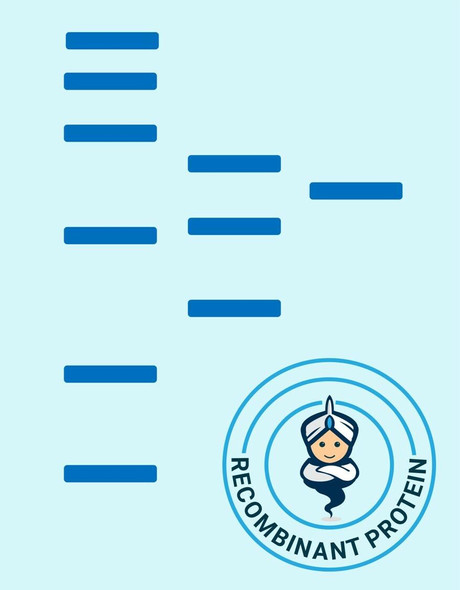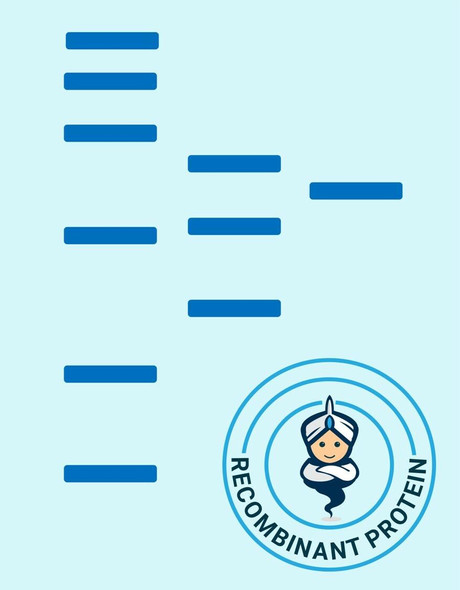Cytokines Recombinant Proteins
Human TACI Recombinant Protein (RPPB0958)
- SKU:
- RPPB0958
- Product Type:
- Recombinant Protein
- Species:
- Human
- Uniprot:
- O14836
- Research Area:
- Cytokines
Description
| Product Name: | Human TACI Recombinant Protein |
| Product Code: | RPPB0958 |
| Size: | 10µg |
| Species: | Human |
| Target: | TACI |
| Synonyms: | TumorNecrosis Factor Receptor Superfamily Member 13B, Tumor Necrosis Factor ReceptorSuperfamily, Member 13B, Transmembrane Activator And CAML Interactor ,TACI ,Tumor Necrosis Factor Receptor 13B, CD267 Antigen, TNFRSF14B, CD267, CVID2, IGAD2,CVID, RYZN. |
| Source: | Sf9 Insect cells |
| Physical Appearance: | Sterilefiltered colorless solution. |
| Formulation: | TACIa protein solution (0.25mg/ml) contains Phosphate Buffered Saline (pH 7.4), 30%glycerol and 1mM DTT. |
| Stability: | Store at 4°C if entire vial will be used within 2-4 weeks.Store, frozen at -20°C for longer periods of time. For long term storage it is recommended to add a carrier protein (0.1% HSA or BSA).Avoid multiple freeze-thaw cycles. |
| Purity: | Greaterthan 90.0% as determined by SDS-PAGE. |
| Amino Acid Sequence: | ADLMSGLGRS RRGGRSRVDQEERFPQGLWT GVAMRSCPEE QYWDPLLGTC MSCKTICNHQ SQRTCAAFCR SLSCRKEQGK FYDHLLRDCI SCASICGQHPKQCAYFCENK LRSPVNLPPE LRRQRSGEVE NNSDNSGRYQ GLEHRGSEAS PALPGLKLSA DQVALVYSLEPKSCDKTHTC PPCPAPELLG GPSVFLFPPK PKDTLMISRT PEVTCVVVDV SHEDPEVKFN WYVDGVEVHNAKTKPREEQY NSTYRVVSVL TVLHQDWLNG KEYKCKVSNK ALPAPIEKTI SKAKGQPREP QVYTLPPSRDELTKNQVSLT CLVKGFYPSD IAVEWESNGQ PENNYKTTPP VLDSDGSFFL YSKLTVDKSR WQQGNVFSCSVMHEALHNHY TQKSLSLSPG KHHHHHH |
TNFRSF13B (TACI) is a transmembrane receptor protein found predominantly on the surface of B cells (a significant part of the immune system). TACI was at first discovered owing to its ability to interact with calcium-modulator and cyclophilin ligand (CAML). Later on, it was found that TACI plays a key role in humoral immunity by interacting with two members of the TNF family. Also, TACI controls T cell-independent B cell antibody responses, isotype switching, and B cell homeostasis.
TACI produced in Sf9 Insect cells is a single, glycosylated polypeptide chain containing 407 amino acids (1-165a.a.) and having a molecular mass of 45.8kDa (Molecular size on SDS-PAGE will appear at approximately 25-50kDa). TACI is expressed with a 242 amino acid hIgG-His tag at C-Terminus and purified by proprietary chromatographic techniques.
| UniProt Protein Function: | TNFRSF13B: Receptor for TNFSF13/APRIL and TNFSF13B/TALL1/BAFF/BLYS that binds both ligands with similar high affinity. Mediates calcineurin-dependent activation of NF-AT, as well as activation of NF-kappa-B and AP-1. Involved in the stimulation of B- and T- cell function and the regulation of humoral immunity. Defects in TNFRSF13B are the cause of immunodeficiency common variable type 2 (CVID2). CVID2 is a primary immunodeficiency characterized by antibody deficiency, hypogammaglobulinemia, recurrent bacterial infections and an inability to mount an antibody response to antigen. The defect results from a failure of B-cell differentiation and impaired secretion of immunoglobulins; the numbers of circulating B-cells is usually in the normal range, but can be low. Defects in TNFRSF13B are a cause of immunoglobulin A deficiency 2 (IGAD2). Selective deficiency of immunoglobulin A (IGAD) is the most common form of primary immunodeficiency, with an incidence of approximately 1 in 600 individuals in the western world. Individuals with symptomatic IGAD often have deficiency of IgG subclasses or decreased antibody response to carbohydrate antigens such as pneumococcal polysaccharide vaccine. Individuals with IGAD also suffer from recurrent sinopulmonary and gastrointestinal infections and have an increased incidence of autoimmune disorders and of lymphoid and non-lymphoid malignancies. In vitro studies have suggested that some individuals with IGAD have impaired isotype class switching to IgA and others may have a post-switch defect. IGAD and CVID have been known to coexist in families. Some individuals initially present with IGAD1 and then develop CVID. These observations suggest that some cases of IGAD and CVID may have a common etiology. 2 isoforms of the human protein are produced by alternative splicing. |
| UniProt Protein Details: | Protein type:Cell cycle regulation; Membrane protein, integral; Receptor, misc. Chromosomal Location of Human Ortholog: 17p11.2 Cellular Component: integral to plasma membrane; external side of plasma membrane Molecular Function:protein binding; receptor activity Biological Process: cell surface receptor linked signal transduction; B cell homeostasis; hemopoietic progenitor cell differentiation; negative regulation of B cell proliferation Disease: Immunodeficiency, Common Variable, 2; Immunoglobulin A Deficiency 2 |
| NCBI Summary: | The protein encoded by this gene is a lymphocyte-specific member of the tumor necrosis factor (TNF) receptor superfamily. It interacts with calcium-modulator and cyclophilin ligand (CAML). The protein induces activation of the transcription factors NFAT, AP1, and NF-kappa-B and plays a crucial role in humoral immunity by interacting with a TNF ligand. This gene is located within the Smith-Magenis syndrome region on chromosome 17. [provided by RefSeq, Jul 2008] |
| UniProt Code: | O14836 |
| NCBI GenInfo Identifier: | 21264086 |
| NCBI Gene ID: | 23495 |
| NCBI Accession: | O14836.1 |
| UniProt Secondary Accession: | O14836,Q32LX4, Q7Z6F5, B2R8B0, B7Z6V8, |
| UniProt Related Accession: | O14836 |
| Molecular Weight: | 19,865 Da |
| NCBI Full Name: | Tumor necrosis factor receptor superfamily member 13B |
| NCBI Synonym Full Names: | tumor necrosis factor receptor superfamily, member 13B |
| NCBI Official Symbol: | TNFRSF13B�� |
| NCBI Official Synonym Symbols: | CVID; RYZN; TACI; CD267; CVID2; IGAD2; TNFRSF14B�� |
| NCBI Protein Information: | tumor necrosis factor receptor superfamily member 13B; tumor necrosis factor receptor 13B; transmembrane activator and CAML interactor |
| UniProt Protein Name: | Tumor necrosis factor receptor superfamily member 13B |
| UniProt Synonym Protein Names: | Transmembrane activator and CAML interactor; CD_antigen: CD267 |
| UniProt Gene Name: | TNFRSF13B�� |
| UniProt Entry Name: | TR13B_HUMAN |






